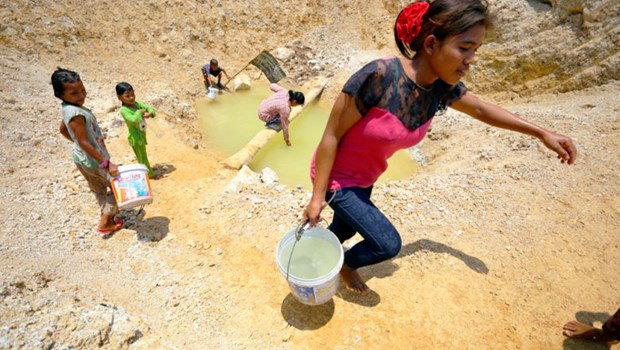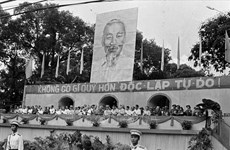Cambodia farmers advised not to cultivate crops as drought peaks
Cambodia’s Ministry of Environment has told its rice farmers to refrain from planting crops as the country is in the midst of a drought heightened by record temperatures due to this year’s El Nino phenomenon.
 Villagers collect water at a dwindling watering hole amid drought in Banteay Meanchey province, Cambodia, in 2016 (Source: phnompenhpost.com)
Villagers collect water at a dwindling watering hole amid drought in Banteay Meanchey province, Cambodia, in 2016 (Source: phnompenhpost.com)Hanoi (VNA) – Cambodia’s Ministry of Environment has told its rice farmers to refrain from planting crops as the country is in the midst of a drought heightened by record temperatures due to this year’s El Nino phenomenon.
Talking to Cambodia’s The Phnom Penh Post newspaper, Neth Pheaktra, Spokesperson and Secretary of State for the Ministry of Environment, said temperatures are expected to peak in April and May and that the government is appealing to people not to plant during this period.
Many communities in 16 provinces around the Southeast Asian country have reported water shortages due to increased average temperatures – a stark reality for a nation more accustomed to dealing with floods than droughts.
The ministry has coordinated with the Ministry of Water Resources and Meteorology in distributing fertilisers and water to communities hit by drought.
Meanwhile, the Mekong River Commission (MRC) Secretariat, which works to jointly manage the water resources of the river shared by member nations Cambodia, Laos, Thailand and Vietnam, said it is ready to support its member countries, including Cambodia which is experiencing abnormally high temperatures.
According to the Cambodian Ministry of Environment, the temperature in the country is likely to reach 40-42 degrees Celsius between April and May this year.
Higher temperatures associated with the El Nino phenomenon could lead to forest fires and water shortages, it said.
The MRC Secretariat said that along with lower agricultural productivity, people’s livelihoods and health could be affected this season.
According to the UN’s Food and Agriculture Organisation, about 75 percent of cultivated land in Cambodia is used for rice farming and the country supplies about 3 percent of the world’s total global rice output. The El Nino phenomenon also caused a serious drought in Cambodia in 2016 which was considered the country’s worst natural disaster in a century. –VNA













